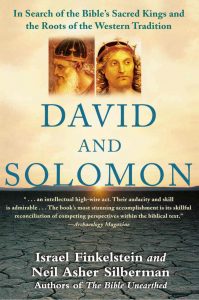Como anunciado aqui, saiu o novo livro de Israel Finkelstein e Neil Asher Silberman.
FINKELSTEIN, I.; SILBERMAN, N. A. David and Solomon: In Search of the Bible’s Sacred Kings and the Roots of the Western Tradition. New York: The Free Press, 2006, 352 p. – ISBN 9780743243636
A editora oferece a seguinte descrição da obra:
The exploding number of discoveries of biblical archaeology – artifacts and texts found at hundreds of sites populated in the ancient Near East – have shed powerful  beams of light on the characters and peoples in the Bible. Most of the resulting public controversies have focused on whether or not the history in the Bible is true. Yet ultimately, there are two larger questions that matter more: exactly how did the Bible evolve into its final form, over the centuries-long process of its compilation, and what does that history tell us about the traditions we have inherited and that still stamp our memories?
beams of light on the characters and peoples in the Bible. Most of the resulting public controversies have focused on whether or not the history in the Bible is true. Yet ultimately, there are two larger questions that matter more: exactly how did the Bible evolve into its final form, over the centuries-long process of its compilation, and what does that history tell us about the traditions we have inherited and that still stamp our memories?
In David and Solomon, Israel Finkelstein and Neil Asher Silberman, leading archaeologists and authors who have done a great deal to uncover and understand the breathtaking findings of their field, focus on the first two great kings of the Bible as a lens through which we can see the evolution of the entire biblical era. The Bible’s chapters and verses on David and his son were written in stages, over many hundreds of years, by authors living in very different circumstances. Thanks to a combination of textual analysis and archaeology, we now know a great deal about which parts of the story were written in which era, and why those particular societies might have added to the legend precisely as they did. In short, David and Solomon offers a guide to a thousand years of ancient civilization and the evolution of a tradition of kingly leadership that held sway throughout the West for much of our history.
The earliest folklore and verses about David depict a bandit leader, hiding in the mountains, leading a small gang of traveling raiders (which fits what we know of the ninth century B.C.E.). That bandit may well be the “true” David. In later periods, authors added images of David as a poet, as the founder of a great dynasty, as a political in-fighter, and (perhaps most famously) as a sinner. All of these images made sense for the authors who created them, and a similar evolution of Solomon from the builder of the Temple, to expander of his empire, to wise sage, to rich trader similarly reflects the successive stages of history up to the time of Jesus. Ultimately, David and Solomon came to embody a tradition of divinely inspired kings and even messiahs, the forerunners of Jesus and of the great kings of Europe throughout the Middle Ages.
David and Solomon shows how the stories built around two men reflect the very roots of the western tradition and explains a great deal of why the Bible appears as it does.
